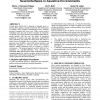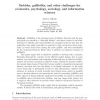1338 search results - page 251 / 268 » Understanding Social Robots |
PETRA
2009
ACM
14 years 2 months ago
2009
ACM
Loosing motor activity due to impaired or damaged nerves or muscles affects millions of people world-wide. The resulting lack of mobility and/or impaired communication bears enorm...
ATAL
2003
Springer
14 years 22 days ago
2003
Springer
Effective coordination of robots, agents and people promises to improve the safety, robustness and quality with which shared goals are achieved by harnessing the highly heterogene...
AISB
2008
Springer
13 years 9 months ago
2008
Springer
Philosophy, artificial intelligence and cognitive science have long been dominated by the presupposition that intelligence is fundamentally individual. Recent work in cognitive sci...
ATAL
2010
Springer
13 years 8 months ago
2010
Springer
Multi-agent learning is a crucial method to control or find solutions for systems, in which more than one entity needs to be adaptive. In today's interconnected world, such s...
FIRSTMONDAY
2010
13 years 4 months ago
2010
Abstract. Gullibility is the principal cause of bubbles. Investors and the general public get snared by a "beautiful illusion" and throw caution to the wind. Attempts to ...



